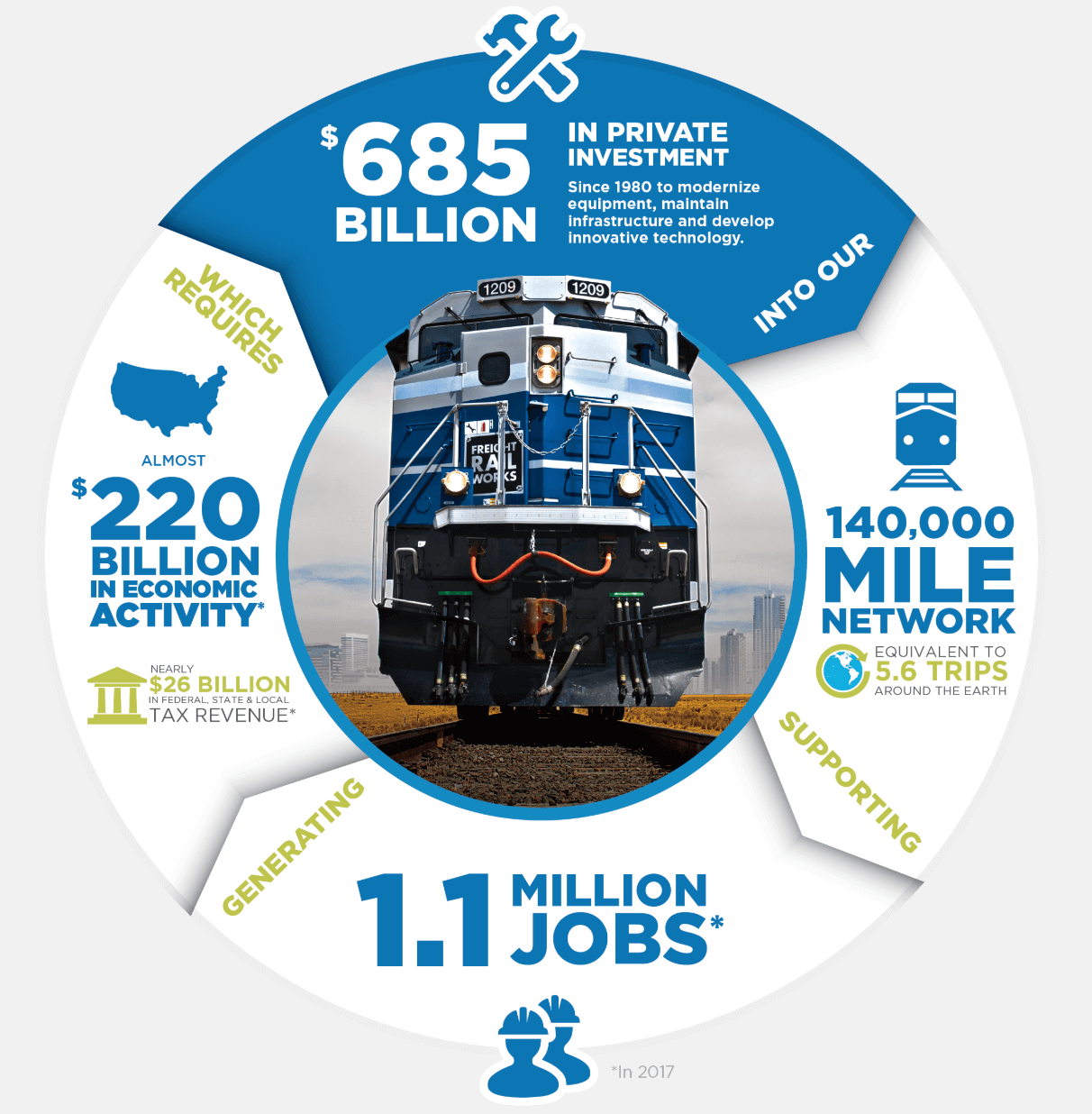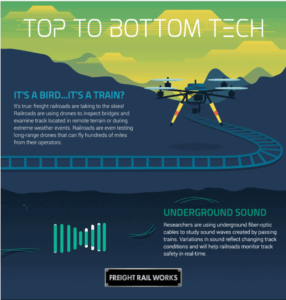Each year in the US, freight railroads move “more than two billion tons . . . across 140,000 miles of privately-owned infrastructure” 1 supporting 1.1 million jobs and generating hundreds of billions in economic activity and tax revenue:
 Keeping that infrastructure in tip-top shape is critical, and that means operators must have the best training possible, and with an eye toward constant improvement. Every mishap avoided offers exponential ROI, year after year.
Keeping that infrastructure in tip-top shape is critical, and that means operators must have the best training possible, and with an eye toward constant improvement. Every mishap avoided offers exponential ROI, year after year.
Although they’re already safer than ever before, there’s always room to do better, as the industry’s focus on emerging technologies demonstrates. And simulated 3D trainings can help railroads meet these needs.
Safer Than Ever Before
There’s never been a safer time to travel or send goods by rail, with recent times marking the safest in the industry’s nearly 200-year-old history2 – and the numbers keep getting better.
Understanding that nothing can ever be 100% safe though, the industry keeps crisis response top-of-mind. And an essential part of this capability is continuous training for the many functions that keep railways moving, including engineers, dispatch, law enforcement, IT, industrial development and more.
So, what are the trouble spots?
There are three different kinds of errors (outside of natural disasters and bad actors) that can happen in the field – and they are: track, equipment and human error. The last, arguably, looms largest in more ways than one – and needs to be addressed with an equal number of solutions.
Human Error
Human error is, by far, the most prevalent concern, accounting for 38% of all accidents in 2017. 2 And really, when one thinks about it, it’s the root problem in most track and equipment errors as well, as track and equipment errors can typically be traced back to human error. Thorough inspection of each could significantly lessen losses in those areas. Not that these inspections aren’t already happening! They are. But we’ll touch back on this in a just a little bit.
Thanks to the Rail Safety Improvement Act of 2008 (RSIA), Positive Train Control systems were mandated a decade ago. PTCs are made up of “technologies designed to automatically stop a train before certain accidents related to human error occur. . . . [consisting of ] Hundreds of thousands of components, [forming] an interconnected network of freight, passenger and commuter railroads.” 3
 But what happens if one link in that network has a glitch or malfunctions? There are redundancies built in to account for each, of course – and one of those safeguards likely includes a human at the helm inspecting PTCs themselves. There’s always a human somewhere in the line, and much like the equipment we program, mistakes/glitches are inevitable.
But what happens if one link in that network has a glitch or malfunctions? There are redundancies built in to account for each, of course – and one of those safeguards likely includes a human at the helm inspecting PTCs themselves. There’s always a human somewhere in the line, and much like the equipment we program, mistakes/glitches are inevitable.
Track and equipment errors have been greatly reduced since 2008, thanks to PTCs and advanced equipment inspection technology, as well as industry-wide asset management programs.
The “top to bottom tech” uses drones and underground sensors to inspect bridges and track located in remote areas, while capturing and monitoring sound vibrations in real-time.
The value of advanced technological capabilities has been realized, to the tune of $25 billion saved each year from reducing track-related errors alone.
But imagine the ROI potential if railroads could conquer the human error factor as well?
They can.
 Decreasing Human Error (systematically)
Decreasing Human Error (systematically)
There are apps available today to guide railway first responders in emergency situations, alerting them to information around what a railcar is carrying and other real-time data.
But the real value of simulation based training comes in avoiding those situations in the first place! Compliance training for railroad industry regulations like CFR 232, 215 (part of a wider initiative for meeting FRA Part 243 training requirements) is becoming top of mind for most railroad companies.
There is really good news here. Portable, scalable, lightweight interactive simulations and guides are allowing railroad employees to not only learn visually, but self-assess and attain proficiency by repeated virtual practice – anytime, anywhere. Railroads are able to evaluate their employee’s skills before they go onto the field and rectify any incorrect knowledge in advance.
As far as direct ROI, it also reduces the need for live equipment costs like locomotives and freight cars designated for training. The simulated “training by doing” commits the actions to memory and are retained in a way that one-off training sessions, reading from a response manual or watching a video can’t come close to replicating.
Anytime access to these Sims keeps skills fresh and helps ensure irregularities aren’t missed. This training provides individualized assessments and practice in areas where each Conductor or Mechanic may need it, while tallying and sharing results with a training facilitator overseeing the results.
An example of this can be seen in this video (the 2:03 mark) where we developed a compliance training simulation for the Railroad Air Brake Test (CFR 232):
The ROI of simulation training, as with other technological advances, will build with time, inevitably decreasing human error to negligible levels and enhancing safety in revolutionary ways.
The freight rail sector is among the safest in the nation, 4 and simulated 3D interactive training will help make it the safest of all.
See a growing catalog of portable and scalable simulations (Air Brake Test, Pre-Departure Inspection, Locomotive Daily Inspection & more) available for your team to deploy today. Please email or call and let’s discuss more.
1 Railroads & States [source: https://www.aar.org/data-center/railroads-states/]
2 Technology: Enhancing an Already Safe Network [source: https://www.aar.org/wp-content/uploads/2018/05/AAR-Safety-Technology-Issue.pdf]
3 Improving Safety Through Positive Train Control [source: https://www.aar.org/campaigns/ptc/]
4 Freight Rail Safety [source: https://www.aar.org/topic/safety/]


